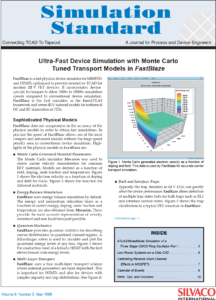Ultra-Fast Device Simulation with Monte Carlo Tuned Transport Models in FastBlaze
FastBlaze is a fast physical device simulator for MESFETs and HEMTs optimized to provide interactive TCAD for modern III-V FET devices. It incorporates device-specific techniques to allow 1000x to 10000x simulation speeds compared to conventional device simulation. FastBlaze is the first simulator in the FastATLAS framework and covers III-V material models for isothermal DC and RF simulation of FETs.
Sophisticated Physical Models
FastBlaze does not compromise in the accuracy of the physical models in order to obtain fast simulations. In practice the speed of FastBlaze allows use of the most complex and advanced models without the huge speed penalty seen in conventional device simulation. Highlights of the physical models in FastBlaze are:
- Monte Carlo Generated Material Parameters
The Monte Carlo simulator Mocasim was used to derive carrier velocity characteristics for common III-V materials. Models are derived as a function of field, doping, mole fraction and temperature. Figure 1 shows the electron velocity as a function of doping and field for GaAs. Figure 2 shows the function for different materials. - Energy Balance Simulation
FastBlaze uses energy balance simulation by default. The energy and momentum relaxation times as a function of carrier energy, doping, mole fraction and temperature are also obtained from Mocasim. These provide the most accurate representation of velocity overshoot and non-local transport possible. - Quantum Mechanics
FastBlaze provides quantum statistics for describing carrier distributions in quantized channel regions. A Schrodinger solver is used to calculate and plot the quantized energy levels at any bias. Figure 3 shows the conduction band of a InGaAs HEMT with the first eleven bound-state energy levels. - Multi-Layer Transport
FastBlaze uses a true multi-layer transport scheme where material parameters are layer dependent. This is important for HEMTs and also for devices with complex impurity and trap distributions. (See Figure 4) - Bulk and Interface Traps
Typically the trap densities in III-V FETs can greatly affect the device performance. FastBlaze allows definition of multiple trap states both for bulk traps such as EL2 and interface surface states. Figure 5 shows the trap distribution in a typical FET structure in FastBlaze.



